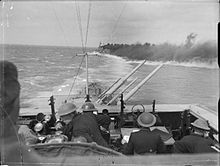SS Clan Campbell (1937)
 Clan Campbell in port
| |
| History | |
|---|---|
| Name | Clan Campbell |
| Namesake | Clan Campbell |
| Owner | Clan Line Steamers Ltd[1] |
| Operator | Cayzer, Irvine & Co Ltd[1] |
| Port of registry | |
| Builder | Greenock Dockyard Co,[1] Scotland |
| Yard number | 427[2] |
| Launched | 14 January 1937[2] |
| Completed | 1937[1] |
| Identification |
|
| Fate | Sunk by bombing, 23 March 1942[2] |
| General characteristics | |
| Class and type | Cameron-class cargo steamship |
| Tonnage | |
| Length | 463.7 feet (141.3 m) p/p |
| Beam | 63.0 feet (19.2 m)[1] |
| Depth | 29.9 feet (9.1 m)[1] |
| Installed power | 1,362 NHP[1] |
| Propulsion | two 3-cylinder triple-expansion engines; two low-pressure exhaust steam turbines; twin screw[1] |
| Speed | 17.5 knots (32.4 km/h)[2] |
| Sensors and processing systems |
|
| Armament | DEMS |
| Notes | sister ships: Clan Buchanan, Clan Cameron, Clan Chattan, Clan Cumming, Clan Ferguson, Clan Forbes, Clan Fraser, Clan Lamont, Clan Menzies, HMS Engadine |
SS Clan Campbell was a
Building

Clan Campbell was launched on 14 January 1937.[2] She was one of a sub-class of 11 Cameron-class ships of identical dimensions, built in 1937–41 by the Greenock Dockyard Company on the River Clyde at Greenock in Renfrewshire: Clan Buchanan, Clan Cameron, Clan Chattan, Clan Campbell, Clan Cumming, Clan Ferguson, Clan Fraser, Clan Forbes, Clan Lamont, Clan Menzies and HMS Engadine.
Clan Campbell's boilers had a combined heating surface of 17,780 square feet (1,652 m2) and supplied steam at 220
Early war service
In 1939 Clan Campbell sailed home with
In 1940 Clan Campbell sailed with Convoy OA 114, which assembled off
Operation Tiger
For UK ships of their era, Cameron-class ships were notable for their speed. Therefore, in 1941 they were among the merchant ships chosen to help relieve the
Empire Song was owned by the Ministry of War Transport but, like the three Clan Liners, was managed by Cayzer, Irvine & Co Ltd. On 9 May she was sunk by a mine off Malta,[11] but New Zealand Star and the three Camerons safely delivered their cargos, including over 200 Matilda II and Crusader tanks to Alexandria.
MW convoys and loss
In 1942 Clan Campbell, her sister ship Clan Chattan and the
On 20 March Clan Campbell again left Alexandria for Malta, this time as one of four cargo ships with
On 22 March four Italian cruisers tried to intercept the convoy but the Royal Navy escorts drove them off in a short engagement. That afternoon the Italian battleship Littorio arrived, escorted by two cruisers. The British attacked with torpedoes against heavy odds, again forcing the Italians to break off and retire. Off Malta on 23 March aircraft attacked the convoy. Clan Campbell was hit by bombs and a torpedo. 10 members of her complement were killed, and she was abandoned and sank.[15] The other cargo ships reached Malta on 24 March but were sunk by air attacks: Pampas[16] and the Norwegian Talabot[17] on 26 March and the cargo liner MV Breconshire the following day.[18]
Clan Campbell's Master, JF Vooght, was among the dead. He was posthumously awarded the MBE and Lloyd's War Medal for Bravery at Sea.[19]
References

- ^ a b c d e f g h i j k l m n o p q r s Lloyd's Register, Steamers and Motorships (PDF). London: Lloyd's Register. 1940. Retrieved 20 December 2013.
- ^ )
- ^ Hague, Arnold. "Convoy HG.5". HG Convoy Series. Don Kindell, ConvoyWeb. Retrieved 20 December 2013.
- ^ Hague, Arnold. "Convoy OA.38". OA Convoy Series. Don Kindell, ConvoyWeb. Retrieved 20 December 2013.
- ^ Hague, Arnold. "Convoy OA.114". OA Convoy Series. Don Kindell, ConvoyWeb. Retrieved 20 December 2013.
- ^ Hague, Arnold. "Convoy AP.3/1". AP Convoy Series. Don Kindell, ConvoyWeb. Retrieved 20 December 2013.
- ^ Hague, Arnold. "Convoy US.5A". Shorter Convoy Series. Don Kindell, ConvoyWeb. Retrieved 20 December 2013.
- ^ Hague, Arnold. "Convoy BS.9". Shorter Convoy Series. Don Kindell, ConvoyWeb. Retrieved 20 December 2013.
- ^ Hague, Arnold. "Convoy WS.8A". Shorter Convoy Series. Don Kindell, ConvoyWeb. Retrieved 20 December 2013.
- ^ Hague, Arnold. "Convoy Tiger". Shorter Convoy Series. Don Kindell, ConvoyWeb. Retrieved 20 December 2013.
- ^ Allen, Tony; Vleggeert, Nico (25 January 2010). "SS Empire Song [+1941]". The Wreck Site. Retrieved 20 December 2013.
- ^ Hague, Arnold. "Convoy MW.9A". Shorter Convoy Series. Don Kindell, ConvoyWeb. Retrieved 20 December 2013.
- ^ Vleggeert, Nico (24 July 2012). "MV Rowallan Castle (+1942)". The Wreck Site. Retrieved 20 December 2013.
- ^ Hague, Arnold. "Convoy MW.10". Shorter Convoy Series. Don Kindell, ConvoyWeb. Retrieved 20 December 2013.
- ^ Allen, Tony (6 August 2013). "SS Clan Campbell (+1942)". The Wreck Site. Retrieved 20 December 2013.
- ^ Lettens, Jan; Allen, Tony (28 August 2008). "MV Pampas (after Part) [+1942]". The Wreck Site. Retrieved 20 December 2013.
- ^ Lettens, Jan; Racey, Carl (30 November 2012). "MV Talabot [+1949]". The Wreck Site. Retrieved 20 December 2013.
- ^ Lettens, Jan; Aquilina, Kevin (12 August 2011). "MV Breconshire [+1942]". The Wreck Site. Retrieved 20 December 2013.
- ^ de Neumann, Bernard (19 January 2006). "Lloyd's War Medal for Bravery at Sea (Part Two)". WW2 People's War. BBC. Retrieved 20 December 2013.
